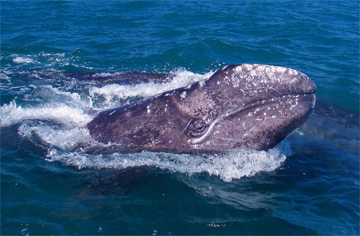Global warming affects whale populations already reduced by historic whaling
Gray whale populations only a fraction of historic level
mongabay.com
September 10, 2007
|
|
The current population of gray whales is one-third to one-fifth of the number found in the Pacific before industrial whaling began in the 19th century, reports a new study based on genetic analysis.
Analyzing DNA samples from 42 gray whales, Elizabeth Alter (Stanford University), Eric Rynes (University of Washington), and Stephen R. Palumbi (Stanford University) found that DNA variation suggests a historical Pacific gray whale population of
76,000 to 118,000, well above the current estimate of 22,000 gray whales alive today. The results challenge the widely held belief that gray whale populations have returned to their prewhaling abundance and also shed light on the sensitivity of whales to climate change.
“Recent mortality spikes might signal that the population has reached long-term carrying capacity, but an alternative is that this decline was due to shifting climatic conditions on Arctic feeding grounds,” the authors write.
 Gray whales (Eschrichtius robustus) return from Arctic feeding grounds to lagoons in Mexico each winter to give birth. New genetic results indicate that in the past, the number of whales returning to these lagoons may have been much larger. Photo taken in Laguna San Ignacio, Mexico. Image courtesy of Geoff Shester. |
The researchers say that a recent resurgence of birth rates “suggest[s] this population has not yet reached its typical long-term abundance but can continue to grow if current ocean conditions permit.”
“Ecological surveys of gray whale feeding areas on the Bering Sea shelf suggest that this area alone could support 90,000 whales annually,” they continue. “However, recent evidence suggests that gray whale feeding habitat may be declining as Arctic benthic prey populations are reduced because of changing climate in the Bering Sea.”
Given these findings, the authors suggest that gray whales should be treated as a “depleted stock” to reduce human-killing of the species from 417 to 208 per year. Hunting of 125 gray whales per year by indigenous populations is currently allowed by the International Whaling Commission.
Healthy whale populations translate to a healthy ecosystem
Alter, Rynes, and Palumbi say the recovery of gray whale populations would have significant implications for marine ecology. Gray whales play a key ecological role in their Arctic feeding grounds, stirring up sediment that increases nutrient cycling in the ecosystem.
“At previous levels, gray whales may have seasonally resuspended 700 million cubic meters of sediment, as much as 12 Yukon Rivers, and provided food to a million sea birds,” the authors write. “Decreased sediment reworking could dramatically change nutrient recycling, and create shifts in benthic species dominance.”
Feeding by gray whales provides nutrient subsidies from benthic marine communities to terrestrial ones, including food subsidies for at least four species of seabirds that feed on benthic crustaceans brought to the surface by gray whale feeding,” they continue. “We calculate that a population of 96,000 whales could provide food subsidies to 1.03 million birds…. In addition, gray whales may have provided an important food source for predators and scavengers such as orcas and California condors.”
The authors say that given the chance to recover, gray whales could return to their historical abundance in feeding grounds along the coast of Oregon, Washington, British Columbia, and southeast Alaska, returning those ecosystems to better health.
CITATION: S. Elizabeth Alter, Eric Rynes, and Stephen R. Palumbi (2007). DNA evidence for historic population size and past ecosystem impacts of gray whales. PNAS Online Early Edition for the week of September 10-14, 2007.